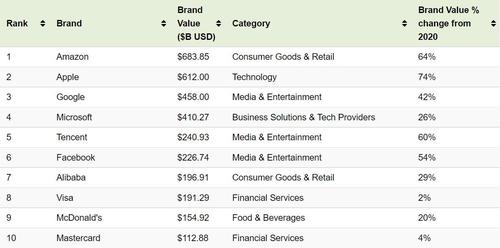Visualizing The World’s 100 Most Valuable Brands In 2021
In 2020, the global economy experienced one of the worst declines since the Great Depression.
Yet, as Visual Capitalist’s Carmen Ang notes, while the ripple effects of COVID-19 have thrown many businesses into disarray, some companies have not only managed to stay afloat amidst the chaos—they’ve thrived. Using data from Kantar BrandZ, this graphic looks at the top 100 most valuable brands of 2021.
Methodology
Each year, research group Kantar BrandZ ranks companies based on their “brand value,” which is measured by:
-
A brand’s total financial value, which is the financial contribution that brand brings to its parent company ($ value).
-
Multiplied by its proportional value, measured by the brands proportional impact on its parent company’s sales (% value).
The financial results are then combined with quantitative survey data, sourced from over 170,000 global consumers. The end result is a holistic look at a company’s brand equity, reputation, and ability to generate value.
The Leaderboard
The total value of 2021’s Top 100 brands grew by 42%, reaching a combined $7 trillion. At the top of the list, perhaps unsurprisingly, is Amazon, with a total brand value of $683 billion.
It’s the third consecutive year that Amazon has placed first on the list. Since last year’s ranking, the ecommerce brand has seen its value grow by 64%. Keep in mind, this accounts for all areas of Amazon’s business, including its web and subscription services.
Second on the list is Apple with a brand value of $612 billion. Apple wasn’t completely immune to the impacts of COVID-19—in the early days of the pandemic, its stock dipped almost 19% from record highs—but the company recovered and reported record-breaking revenue, generating $64.7 billion in Q4 2020.
It’s fitting that the top brands on the list are big tech companies since the pandemic pushed consumers online for both their shopping and entertainment needs. A few social media platforms placed high on the list as well, like Facebook, which rose two ranks this year to score the sixth spot with a brand value of $227 billion.
Instagram and TikTok trailed behind Facebook when it came to total brand value, but both platforms saw exceptional growth compared to last year’s report. In fact, when looking at brand value growth from 2020, both brands scored a spot in the top 10.
Insights into Brand Value Growth
The most valuable brand report has been ranking companies for over a decade, and some overarching factors have stood out as key contributors to brand value growth:
1. The Big Get Bigger
Starting “strong” can give brands an edge. This is because growth rate is closely correlated with high brand equity. In other words, a strong brand will likely see more growth than a weaker brand, which might explain why companies like Amazon and Apple have been able to hold their place at the top for several consecutive years.
Keep in mind, this doesn’t account for industry disruptors. An innovative company could come out of the woodwork next year and give the Big Tech giants a run for their money.
2. Marketing Makes a Difference
The right strategy can make a difference, and even smaller brands can make a splash if the message is impactful. Brands with emotional associations, like pride or popularity, tend to see that translate into brand value growth.
Companies like Nike and Coca-Cola have mastered the art of emotional advertising. For instance, in May last year, Nike released a video urging consumers to stand up for equality, in a video titled, “For Once, Just Don’t Do It.”
3. Smart Investment
It’s not just about developing an effective marketing strategy, it’s about executing that strategy, and continually investing in ways that perpetuate your brand message.
For instance, innovation is the core value of Tesla’s brand, and the electric car company walks the walk—in 2020, the company spent $1.5 billion on R&D.
Tyler Durden
Mon, 10/11/2021 – 22:00
via ZeroHedge News https://ift.tt/3atOzeQ Tyler Durden

